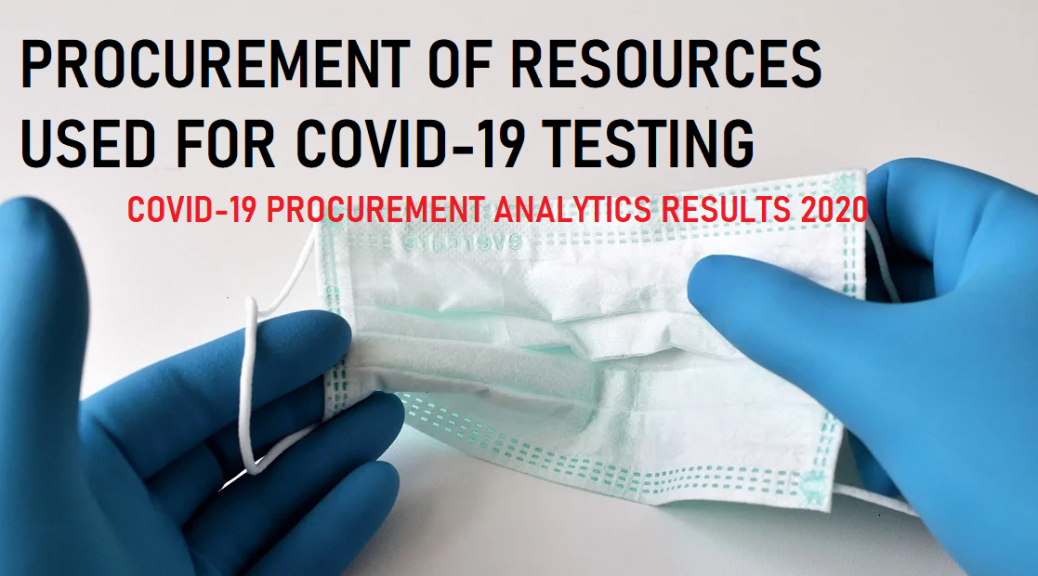This article and the manuscript were submitted by the research team and may be updated in the future.
Conducting this research was both a challenging and fulfilling task. With the alarming health issues surrounding the COVID-19 pandemic, the world is both in a social and economic state of emergency. Life and work are on a standstill as many of us are deeply affected by the COVID lockdown. In spite of its challenges of conducting face to face interviews or data gathering, the experience proved to be a rewarding experience for us for we know that this is a significant contribution to humanity’s collective efforts in combating COVID-19. It is for these reasons that we feel the need for this research.
With the number of COVID-19 cases increasing exponentially, a large number of people are getting infected worldwide, in the Philippines as well as the Bicol Region. In this health crisis, availability of sufficient life-saving goods and services such as testing is essential in the fight against the COVID-19. Hence, supporting the health response including the procurement, allocation and management of essential health facilities and products ensuring that utilization of such limited resources are being managed efficiently is crucial. It is in this context that the study was conducted to analyze available data from the Department of Health (DOH) Data Drop (DOH, 2020) and DOH Regional Office V (DOH-RO V) to evaluate how existing resources are being managed.
The study mainly aims to determine and analyze the procurement transactions made by the Department of Health Regional Office V on testing COVID-19 cases in the Bicol Regional Diagnostic and Reference Laboratory (BRDRL). Particularly, this intends to provide statistics on the specimens processed by the Bicol Regional Diagnostic and Reference Laboratory. It also assessed the procurement management of the resources being purchased by the DOH for use of BRDRL to facilitate the COVID-19 testing and identified the procurement needs of BRDRL through DOH that may further enhance their operation on specimen testing.
How did we go Through the Process?
The study employed the data analytics methods by observing the steps as depicted in Figure 1 such as data scraping, data pre-processing, data processing and analysis and data validation. The evolution from data sources to analysis and validation of results passed through these steps.
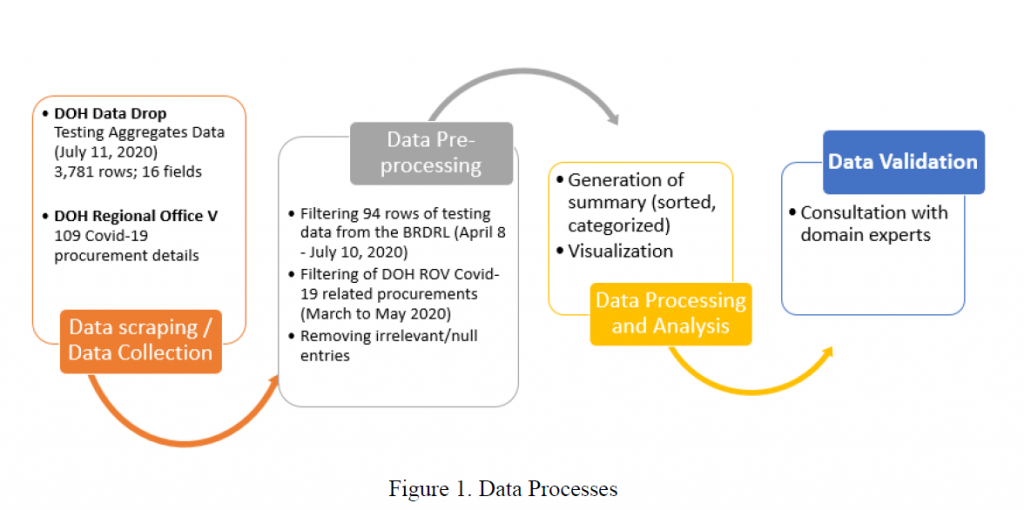
Data Scraping. Data collection was done by scraping data from the DOH Data Drop dated July 11, 2020. Specifically data on testing aggregates was utilized with 3,781 rows and 16 fields. In relation to COVID-19 procurement details, data were provided by the Department of Health Regional Office V. Said data was composed of PR No, particulars, Approved Budget for the Contract (ABC), Contract Amount and Status of approximately 109 procurement activities from March until May 2020.
Data Pre-processing. Data cleaning of data scraped included filtering testing data from the BRDRL. 94 rows were filtered from the Data Drop with reporting dates from April 8, 2020 until July 10, 2020. Fields found relevant on the analysis of aggregate testing data were the facility_name, report_date, daily_output_positive_individuals, daily_output_negative_individuals daily_output_unique_individuals,
daily_output_samples_tested, cumulative_unique_individuals, cumulative_samples_tested, and the remaining_available_tests. Other irrelevant fields and with NULL entry were either corrected or discarded.
For the DOH RO V procurement data, only COVID-19 related activities were considered from the procurement data from March to May 2020.
Data Processing and analysis. After the completion of data pre-processing, the data were sorted, summarized and visualized. A plot of the specimens tested daily at BRDRL was visualized by plotting the daily_output_unique_individuals values versus the daily_output_samples_tested. A graph of the cumulative number of specimens tested daily at BRDRL was likewise prepared by plotting the
cumulative_unique_individuals daily values versus that of the cumulative_samples_tested. Further, the BRDRL daily testing results was plotted with the scraped values for daily_output_positive_individuals, and
the daily_output_negative_individuals. Finally, the remaining PCR testing kits of BRDRL was visualized with the scraped values for the remaining_available_tests. On the other hand, the procurement activities
provided by the DOH ROV undergone processing by categorizing each activity according to its purpose, then computing for the sum and percentages needed for analysis.
Data Validation. The results of the study were sent to DOH ROV for feedback and validation before presenting the results to various stakeholders through a public forum. Comments and suggestions were taken into consideration. Consultation with the procurement personnel of DOH ROV shall be made for further validation of results. Further improvement shall be considered on the processing of next iteration of the study.
What were the salient findings found in the conduct of the study?
Statistics on the specimens processed by the Bicol Regional Diagnostic and Reference Laboratory;
Figure 2 presents the total specimens processed daily with results which could either be positive, negative, equivocal or invalid as well as sum of all unique individuals tested resulting positive or negative released from 6pm the previous day to 6pm of the reporting date. BRDRL started with a testing capacity of 34 samples per day since the laboratory had only one PCR machine. May 16-25, 2020 has zero samples tested since testing at the Bicol Regional Diagnostic and Reference Laboratory (BRDRL) for coronavirus disease 2019 stopped when Typhoon “Ambo” damaged the exhaust duct at the roof of the facility. With the two RT-PCR machines donated by the LGU Legazpi and a private donor, the laboratory in BRDRL can already test 380 to 420 samples per day, but so far 182 is the highest number of total specimens processed in a day, hence testing capacity has not yet been maximized and according to DOH RO V, Bicol has ‘zero backlog’ in COVID-19 testing.
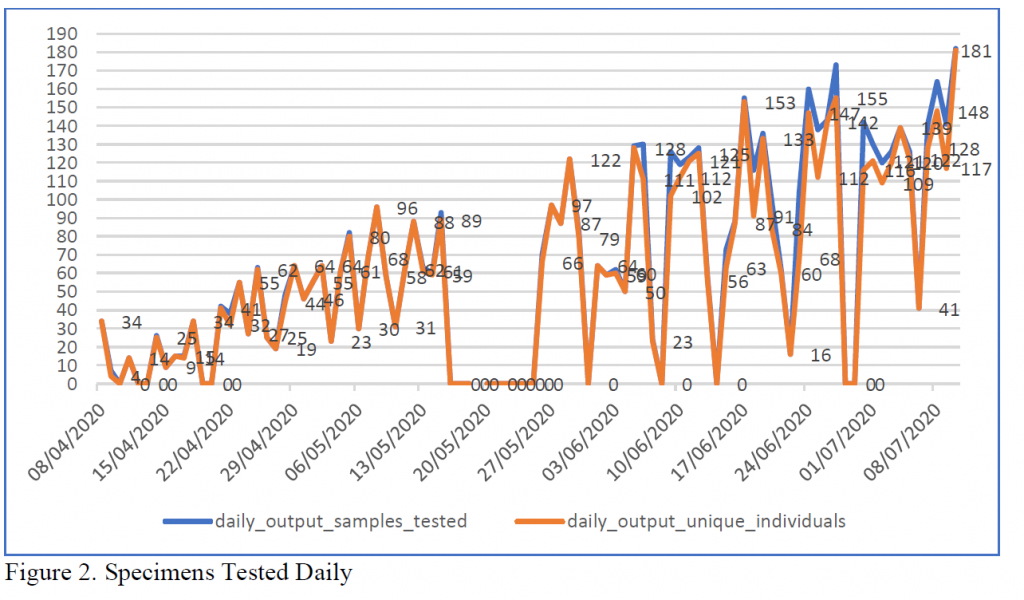
The cumulative number of samples tested which refers to the sum of all specimens tested with validated results from the start of laboratory operation up to the reporting date is presented in figure 3. Further, the cumulative number of unique individuals tested which is the total number of unique individuals who underwent COVID-19 testing, regardless of result, accumulated since the start of operations in the laboratory is likewise presented. It should be noted however, that since an individual may have to undergo the testing more than once, the 2 or more specimen results will only be counted once. As of July 10, a total of 5988 samples and 5629 unique individuals were tested.
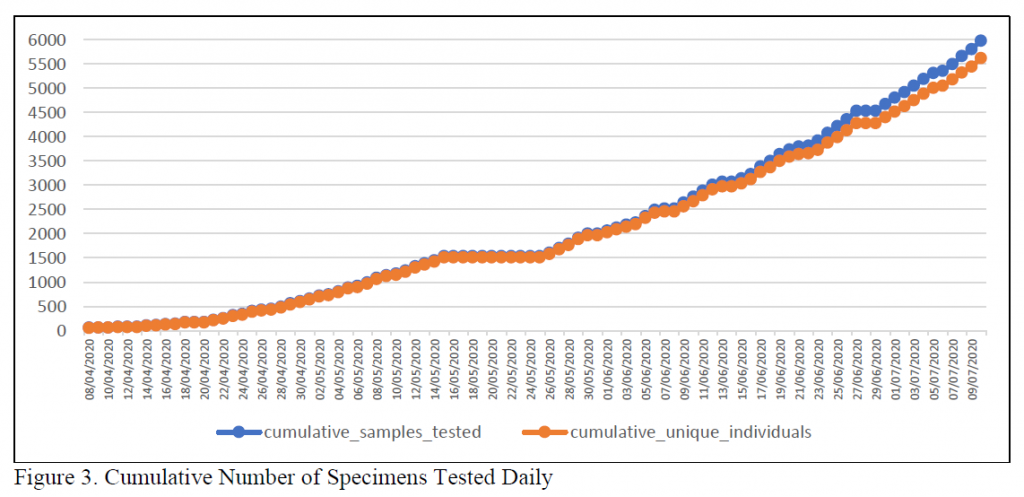
Procurement Management of the Resources Being Purchased by the DOH for Use of BRDRL to Facilitate the COVID-19 Testing
The remaining COVID-19 tests that can be conducted by the BRDRL based on the PCR testing kits they currently have is presented in figure 5. It is evident that as of July 10, 2020, 18,865 tests can still be conducted. It implies that there is available testing kits to conduct COVID-19 testing with Bicol having ‘zero backlog’ in testing.
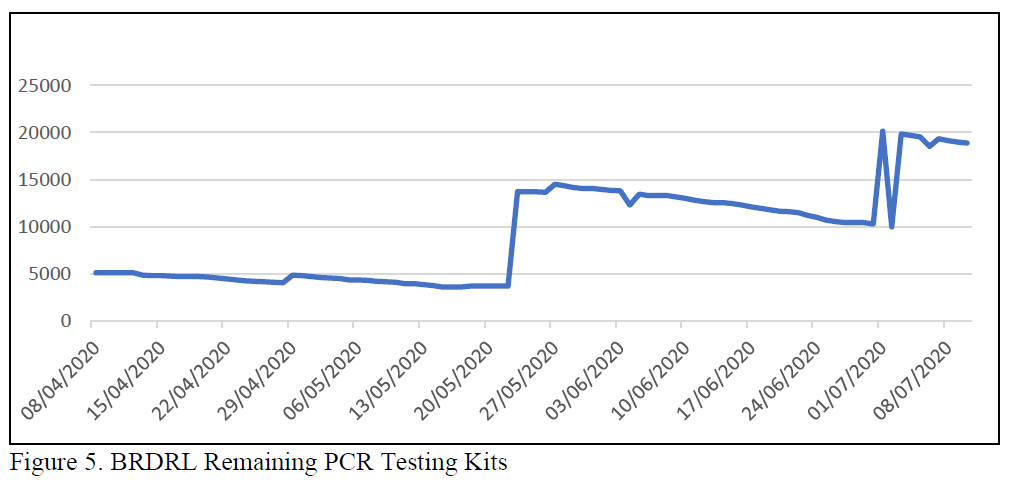
The awarded procurement activities of DOH Regional Office V in relation to COVID-19 is presented in figure 6.
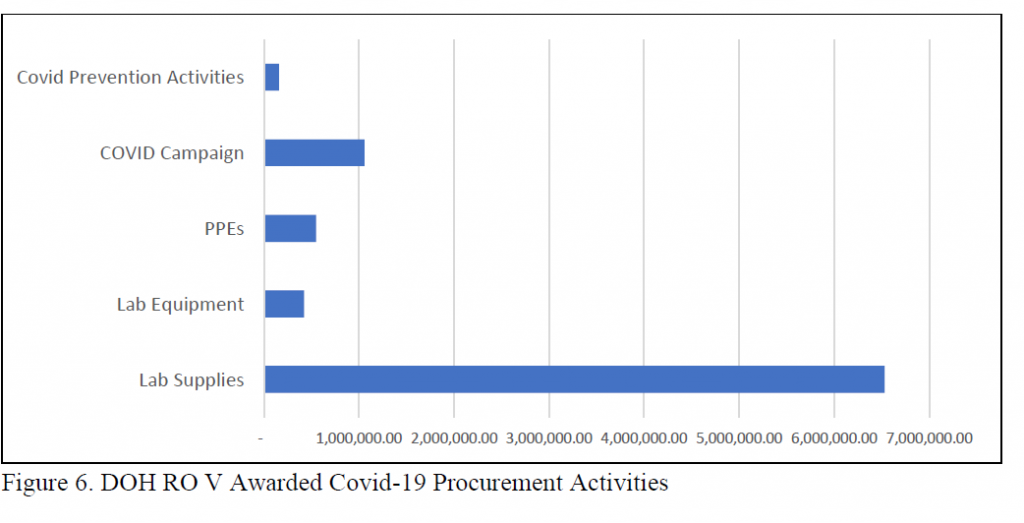
These are the resources being purchased by the DOH for use of BRDRL to facilitate the COVID-19 testing. It is apparent that the biggest procurement cost is on purchase of laboratory supplies followed by conduct of COVID-19 related campaigns, purchase of Personal Protective Equipment (PPE), purchase of laboratory equipment and conduct of COVID-19 prevention activities. For laboratory supplies the highest cost is on purchase of the Viral RNA Extraction kit & Consumables with an approved budget contract of approximately 4 million which is used for testing COVID-19 specimens in BRDRL. COVID-19 campaign activities on the other hand refer to placement of Radio/TV Infomercials as well as various signages for COVID-19 response and containment. Procurement of PPE refers to procurement of surgical gowns, surgical masks, goggles, coverall, shoe cover and head cover which are vital in the conduct of the testing procedures. Further, laboratory equipment includes purchase of equipment such as LED Digital Dry Bath / Dry Block Heater and finally, COVID-19 prevention activities includes activities like accommodation or quarantine for health workers and technicians from NCR as well as anti-bacterial fogging/misting treatment to ensure that the workplace is properly disinfected, ventilated, and maintained as part of infection control procedures.
The Procurement Needs of BRDRL through DOH that may Further Enhance their Operation on Specimen Testing
From the identified COVID-19 related procurement activities of DOH RO V, approximately 8.6 Million worth or 77% is already awarded, 2.5 Million which is 23% is waiting for quotation and 41,000 or 0.37% has a quotation that is above the approved budget as presented in figure 7. This shows that most of the requested items to be purchased has been already awarded and that procurement of resources by the DOH Regional Office V for use of BRDRL to facilitate the COVID-19 testing is well managed with Bicol having ‘zero backlog’ in testing and available PCR testing kits. The remaining 23% procurement needs are presented in figure 6.
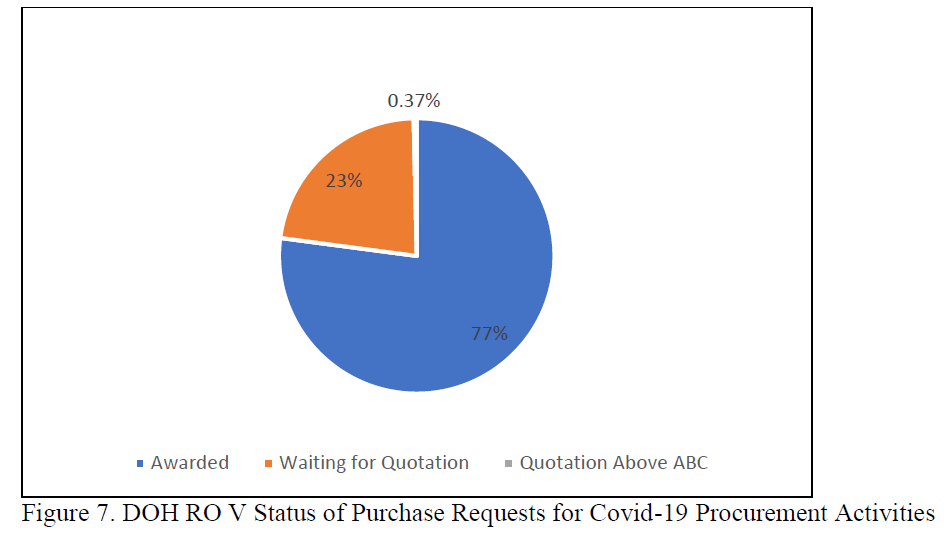
The procurement needs of BRDRL through DOH Regional Office V to further enhance their operation on Covid-19 specimen testing is presented in figure 8. These are the resources being requested by the DOH for use of BRDRL to facilitate the COVID-19 testing which are either still waiting for quotation or has quotation above the approved budget for the contract. It is evident that the biggest procurement cost is on purchase of laboratory supplies followed by purchase of Personal Protective Equipment (PPE), conduct of covid19-related campaigns, purchase of laboratory equipment and repair of Covid-19 laboratory at BRDRL.
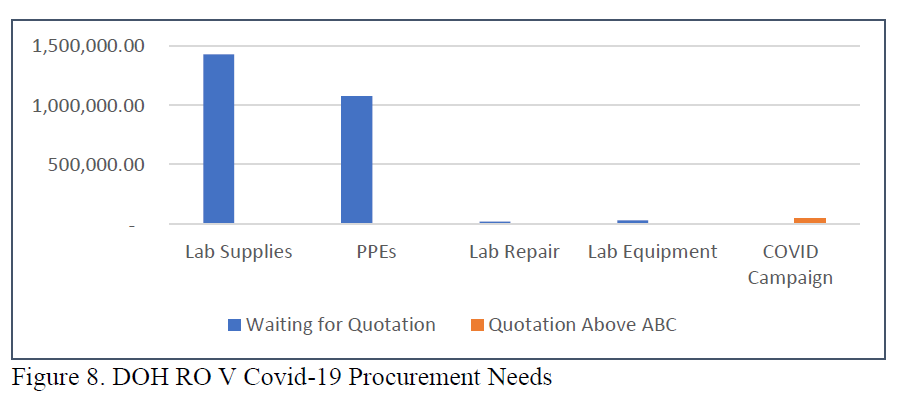
Conclusions
Based on the foregoing findings, the study concluded that DOH Regional Office V so far had shown to have managed well their COVID-19 related procurement activities for BRDRL based on data scraped from the DOH Data Drop and procurement data provided by the DOH ROV with Bicol having ‘zero backlog’ in testing and with available PCR testing kits which can be partly attributed to the strong partnership with the LGU of Legazpi City. Other local government units may replicate the partnership of Legazpi City with DOH. Likewise, innovative partnerships with business and civil society are needed since it is a fact that the DOH cannot win the fight in stopping the spread of COVID-19 without the cooperation and support of stakeholders and the public. Early detection and isolation of new COVID-19 cases is critical to managing potential outbreaks, especially as the government is considering gradually lifting quarantine measures. This makes testing all the more vital.
What’s Next?
During an emergency like the COVID-19 crisis, procurement procedures need to be as fast as possible as it adheres to the rules on Negotiated Procurement (Emergency Case) by simplifying its process as stipulated in the GPPB Resolution No. 03- 2020, however, emergency procedures still need to be public and open. Although the Department of Health Regional Office V was able to provide some procurement data as requested, yet, it would have been more beneficial if said data are disclosed publicly online, in the GPPB online portal, or in their website. With this, the study recommends that open procurement data such as the Annual Procurement Plan FY 2020, request for quotation, technical specifications, purchase order, and notice of award be made available to public since it may enable fairer competition among companies, identify red flags, as well as deliver better services for governments and citizens. Publishing data for each step of the contracting process is highly recommended to promote transparency and accountability. COVID-19 procurement strategies need to be rapidly updated to form a global, digital and data-driven plan since how the government manages emergency public procurement will play a major role in how COVID-19 be contained and how many lives can be saved. Finally, it is also suggested for the GPPB to establish an online platform to allow for an online submission and receipt of bids for procurement modalities by all procuring entities.
So what are then the perceived impacts of the study?
The findings of the study could serve as feedback to the Department of Health Regional Office V on their procurement management of the resources used on testing COVID-19 cases in the Bicol Regional Diagnostic and Reference Laboratory (BRDRL) during this pandemic. Further, the utilization of data analytics in this study could serve as guide to future researchers on the importance of analyzing data sets and how it could give meaning to a simple data, translating data on hand to meaningful stories, thereby building a model for a data-driven decision making. Finally, this could provide an open data accessible to the community members while reinforcing scientific cooperation. Being a researcher requires inspiration, commitment and dedication. Without these, no research shall be accomplished and realized. As Microsoft co-founder Bill Gates said and we quote “I believe in innovation and that the way you get innovation is you fund research and you learn the basic facts.” Hence, this research will only find its meaning when shared with others and others learned from it.
find the presentation of this study below:
 Loading…
Loading…
view the
Reference: 1. DOH. (2020). Updates on Novel Coronavirus Disease (COVID-19). Retrieved July 14, 2020, from https://www.doh.gov.ph/2019-nCoV

